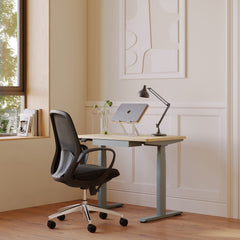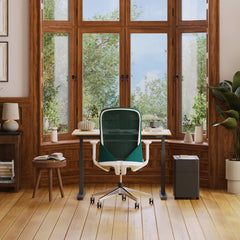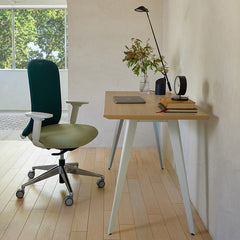Get 10% off your first order
Find the office furniture that’s designed to match your style, comfort, and needs perfectly. Subscribe
Space Shift: The Art of the Live-Work Fusion

Visit quiz page to see how we makes it easy to create an inspiring workplace

 Working from home is now part of daily life, but not everyone has a full room to dedicate as an office. Many people are turning small corners, bedroom nooks, or hallway spaces into work zones. The challenge is making them feel comfortable, organized, and stylish—without feeling cramped. The secret lies in smart planning, multifunctional furniture, and a few creative design tricks.
Working from home is now part of daily life, but not everyone has a full room to dedicate as an office. Many people are turning small corners, bedroom nooks, or hallway spaces into work zones. The challenge is making them feel comfortable, organized, and stylish—without feeling cramped. The secret lies in smart planning, multifunctional furniture, and a few creative design tricks.
Your home office doesn’t need to be large to be effective. With thoughtful choices and clever furniture placement, you can transform any limited space into a productive and inspiring work area. To start, consider using flexible pieces. A modern adjustable standing desk is perfect for small spaces, letting you move from sitting to standing without bulky setups. It not only saves space but also supports better posture and comfort during long hours.
Before you bring in furniture, take time to visualize your space. Every home is different, and your workspace should fit your layout, lighting, and lifestyle.
Ask yourself:
Where do I feel most focused?
Is there enough natural light in this spot?
What items do I really need close at hand?
Choose a quiet area with minimal distractions. Natural light is ideal—placing your desk near a window boosts energy and focus. If you don’t have access to sunlight, layer your lighting: use overhead lighting for brightness and a small lamp for warmth. This simple combination makes even the smallest area feel open and welcoming. The key is intention—designing around your work style instead of forcing your space to adapt.
When space is limited, every inch matters. The layout, furniture placement, and organization all work together to create a balanced, functional setup.
Here are a few practical ways to maximize your small office:
Think vertical: Install wall-mounted shelves or floating ledges to save floor space.
Go mobile: A rolling storage cart or under-desk drawers can add storage without clutter.
Stay minimal: Keep only daily essentials within arm’s reach.
Use corners wisely: A compact desk placed diagonally can open up movement and light flow.
If you want a desk designed for tight layouts yet still stylish, a compact office desk with built-in storage is a smart investment. It offers enough workspace for laptops, planners, and accessories while keeping everything streamlined and tidy.
Your desk is the foundation of your setup. It’s not just a piece of furniture—it’s where you focus, plan, and create. For small rooms, choose something sleek, sturdy, and sized for comfort.
Look for:
A slim surface that fits your workflow
Clean lines and simple finishes
Built-in storage or drawers for small items
If you’re searching for a durable, functional piece that balances design and practicality, consider the Office Table Iowa. It’s crafted for modern workspaces, offering a smooth surface and enough space for essentials—perfect for those who need to maximize every square foot.
A high-quality table like this can anchor your office, giving it structure without taking up visual weight. Pair it with a comfortable chair and smart lighting, and you’ve got a workspace that feels both professional and cozy.

Even if you’re working from a single corner, defining “zones” can make your workspace feel intentional. You don’t need walls—just subtle cues that divide areas by purpose.
Try organizing your setup like this:
Main Zone: Your desk and chair—your productivity hub.
Storage Zone: Floating shelves, drawers, or baskets nearby.
Inspiration Zone: A small board for notes, calendars, or creative ideas.
Relax Zone: A corner with a small plant, soft chair, or candle to unwind.
This zoning approach helps your brain associate each area with a specific task, boosting focus and keeping clutter from creeping in. A small rug or shift in texture can also visually mark the space, separating work from rest.
Comfort should never be sacrificed, no matter how small your office is. Ergonomics keep you healthy, focused, and energized throughout your workday. According to the National Institutes of Health’s ergonomic workspace guide, proper desk height, monitor level, and seating posture can reduce fatigue and strain, improving long-term focus and comfort.
Follow these simple ergonomic principles:
Your monitor should sit at eye level.
Keep feet flat on the floor or a footrest.
Maintain 90-degree angles at elbows and knees.
Adjust lighting to reduce glare and eye strain.
If possible, choose adjustable furniture—especially your chair and desk—so you can switch positions during long hours.
A bright workspace is a productive one. Lighting can change the entire feel of a room—making it look larger, cleaner, and more uplifting.
Here’s how to layer lighting in a compact space:
Natural Light: Position your desk near a window if possible.
Task Lighting: Add a desk lamp with warm tones for direct work.
Ambient Lighting: Use soft overhead or wall lighting to brighten the whole room.
Combining these light sources keeps your workspace functional yet inviting. The goal is to avoid harsh shadows and create balance that feels easy on the eyes.
A home office should reflect who you are—it’s your personal workspace. Even in a small setup, a few thoughtful details can make your environment inspiring.
Try these simple touches:
A potted plant to freshen the air
Framed art or motivational quotes
A corkboard for reminders or mood boards
Neutral decor with a pop of color for energy
Keep decorations minimal so your space feels open. Too many accessories can make a small area feel busy or overwhelming. Focus on items that motivate you or bring calm.
Organization is the backbone of a small office. With limited space, clutter builds quickly and drains focus. Make tidiness part of your routine:
Clear your desk daily
Bundle cables with clips or sleeves
Store papers in labeled folders
Reset your space at the end of each day
These small habits keep your workspace functional and peaceful. A clear desk equals a clear mind.
The layout of your workspace influences how you think and feel throughout your day. Even the placement of a desk near a window can change how light and energy flow through the room.
Place your office desk close to natural light for better alertness.
Use vertical shelves to save ground space.
Keep walkways clear to maintain visual openness.
Anchor your setup with a rug to define your work zone.
A layout that encourages movement and visual balance helps your small space feel lighter and more intentional.
In a small home office, furniture must adapt to your routine. A versatile ergonomic desk and supportive desk chair can make long hours feel effortless, while pieces like a standing desk encourage natural posture changes that enhance focus.
|
Furniture Piece |
Function |
Space-Saving Advantage |
|
Adjustable office table |
Expands or contracts as needed |
Adapts to changing tasks |
|
Foldable seating |
Doubles as extra storage |
Easily tucked away |
|
Wall-mounted desk |
Ideal for narrow spaces |
Converts into a shelf |
|
Mobile cabinet |
Adds storage flexibility |
Slides under the desk |
Every element should serve more than one purpose—whether it’s storing, supporting, or simply giving the illusion of space.

A minimalist setup keeps your mind free of distractions. Clean lines, muted tones, and intentional organization create a workspace that feels larger than it is. Your ergonomic office chairs and streamlined surfaces set the tone for efficiency without excess.
Stick to a neutral palette with one accent color.
Choose light furniture finishes to reflect brightness.
Add vertical accents like plants or narrow lamps.
Keep cables organized with simple cord clips.
A small workspace that looks calm helps you think clearly, stay productive, and enjoy being there—every detail counts.
Even in limited areas, adding subtle personality makes your workspace feel welcoming. A framed quote, a favorite notebook, or a small plant can give warmth without creating clutter.
Use floating frames instead of bulky decor.
Display one meaningful object that motivates you.
Choose textures—like linen or wood—that add softness.
Keep personal items minimal but visible.
Small doesn’t mean plain. When your environment feels intentional, it boosts comfort and motivation naturally.
With a few mindful choices, even the smallest office nook can feel open and inspiring. Good posture, adaptive furniture, and organized surfaces work together to create balance.
Your workspace isn’t defined by square footage—it’s defined by how it supports your focus and creativity. When design and intention align, small spaces become powerful places to think, create, and grow.

Space Shift: The Art of the Live-Work Fusion

How to Arrange Furniture to Maximize Peace

Crafting Calm: Your Guide to the Perfect Reading Corner
Get 10% off your first order
Find the office furniture that’s designed to match your style, comfort, and needs perfectly. Subscribe
Leave a comment